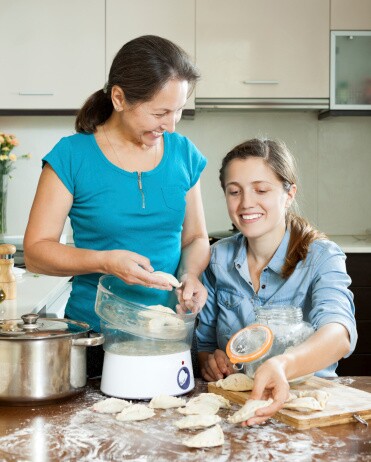
Young women preparing to graduate from high school suddenly come face to face with a frighteningly blank page of future possibilities, each decision lined with a million questions but very few answers: Should I serve a mission? Should I go to college? Should I move away from home? And threaded throughout all of these questions is the dominating, overarching question: how?
It’s an exciting yet overwhelming stage of life. And for these young sisters gearing up for a life of changes, it’s only natural to want to hold onto something familiar. That’s often why young women feel so reluctant to transition from Young Women into Relief Society; they feel at home in laurels and don’t want to add to the changes constantly bombarding them.
Every Relief Society sister can play a vital role in making this transition a welcome one, but it is a process that should begin long before a girl turns 18. Here are five simple principles Church members should keep in mind as they help make Relief Society a refuge for sisters of any age and a place they will continue to seek throughout their lives.
1. Focus on Others
Entering a room full of confident, mature women is intimidating for anyone, especially young sisters unfamiliar with Relief Society. But, this awkwardness is not restricted to new sisters. Older sisters can similarly feel out-of-place approaching young girls who, between all of the tweets and pins and shares, seem to speak an entirely different language.
For both brand new and veteran Relief Society sisters, self-consciousness quickly becomes self-centeredness when it restricts them from seeing others’ needs. Instead of feeling awkward introducing ourselves to new sisters, we should be grateful for any embarrassment we might experience, pain we might suffer, or rejection we might feel because these experiences only help to strengthen our empathy and compassion for others.
Love and charity are the thread that binds us together, the motto which every woman should be striving towards. Seeking opportunities to help others causes us to do much more than look beyond our differences. As we seek to live in charity, we will begin to appreciate and love one another’s differences because they will add new strengths, talents, and possibilities to serve.
But, this system of service and love works both ways. The new sisters in Relief Society have much to offer if they simply find the courage to share. As President Eyring observed in the April General Young Women Meeting, “As you feel of that great sisterhood, what we thought divides us fall away . . . You are more alike as daughters of God than you are different.”

2. Be Honest and Relax
During my protracted transition into Relief Society, one of the greatest tests of my testimony came when I was called as a counselor in my YSA Relief Society presidency. I didn’t even know what Relief Society meant let alone how to lead a group of Relief Society sisters far more experienced. Because of my insecurities, I tried to fit myself into this imagined ideal of what being a “Relief Society sister” meant. I began agonizing over the silliest details, naively thinking I had to be perfect. It wasn’t long before I became overwhelmed and absolutely miserable.
Finally, one day I woke up with this thought: the Lord had called me as the Relief Society counselor, not those women I was trying to imitate. This gave me a little confidence and I decided to change, focusing on the girls instead of myself. And in no time at all, I came to love Relief Society.
As Church members, we seek after perfection--a worthwhile goal. But sometimes, we can get distracted by the wrong types of perfection and ignore the blessings and humility that can result from our weaknesses. In our efforts to increasingly perfect ourselves, we must still be honest with ourselves and others. We should strive to share not only our talents, abilities, and achievements, but also our struggles and fears. This honesty will help develop relationships deeper and stronger than any differences in language, culture, or age that may divide us.
It is important to be genuine, supportive, and open with young sisters. Share your own struggles or mistakes so that they might learn from them. Then, give her the chance to try—and even fail. Remember, relationships are much easier to form when you are relatable.
3. Know the Girls and Help Them Find a Right Fit
The new general women’s meeting has provided an incredible opportunity for women of all ages across the church to come together and build new relationships. Leaders and ward members can build upon this new tie by planning fun activities that incorporate sisters from primary on up. Relief Society, Young Women, and Primary sisters should take care to learn one another’s names and learn more about one another. Just because we meet in separate rooms doesn’t mean we no longer have the responsibility to watch over one another.
I myself was an awkward, reluctant laurel. But my reluctance was only half motivated by shyness. At 17, I learned I was dangerously anemic and spent a good chunk of time in and out of doctor’s offices. Aside from feeling out-of-place in a Relief Society room, I didn’t have the energy to meet new sisters. I avoided the singles ward, fearing that “singles ward” was just a euphemism for the marriage market. I bounced in between Young Women and Relief Society in my family ward, grateful for the friendly smiles but not truly connecting.
Then one day, a previous laurel instructor who had just been called to be an advisor in the singles ward, invited me to go to church with her. I agreed. It took a few additional, awkward months, but I finally began connecting with my new ward. My whole conception of YSA wards and Relief Society shifted. These girls were funny, honest, nice, motivated, and not just there waiting around for an engagement ring. I felt comfortable around them—normal even—and found more energy and optimism in attending Church. Sure, it took persistence and some embarrassment on my part, but once I finally found that place where I belonged, it was undoubtedly worth it.
This perspective flip all came about from the efforts of a Relief Society sister much older than myself, but one who understood me, my personality, and my circumstances. Though simple, young girls notice this type of attention and will respond more willingly to invitations from someone they know cares.

4. Make a Place for the Girls
Expect your daughters and the girls in your ward to attend Relief Society. Expect that they will fulfill their callings faithfully. Expect that they will serve others selflessly. Expect these things, and the young women will rise above your expectations.
Said Sister Julie B. Beck, former Relief Society general president, “The work of Relief Society is relevant for the young women who are entering their adult years. They are ready to serve and ready to participate in a cause that is bigger than themselves. They want to be part of something that changes lives and makes the world a better place.”
Make a place for young sisters to participate in Relief Society and trust them with important assignments and callings. But, be patient. Understand that what may seem obvious or even mundane to you might in fact be something completely new to them. Take the time to explain not only how they can accomplish their new responsibilities, but why they are so crucial. Teaching new sisters with affection and without condescension requires a great deal of tact, finesse, and most importantly, love.
Relief Society teachers should be sensitive to the different ages and circumstances of the women they teach. They should ask young women to participate and give them opportunities to teach. Young girls in turn should not be afraid to speak up. Said Sister M.E. Clayton, “If young women want to have the meetings more geared toward what they’re interested in, participating and becoming part of the program will allow the other women to meet and understand them. If they never participate, they can easily feel left out.”
5. Build Excitement
Entering Relief Society should be an exciting time for a young woman, not just another daily event. Mothers and leaders should help teach their daughters and young women the nature of Relief Society, its roles, and its objectives from a young age so that it becomes something girls look forward to and anticipate.
Said President Joseph Fielding Smith, “You are [or will become] members of the greatest women’s organization in the world, an organization which is a vital part of the kingdom of God on earth and which is so designed and operated that it helps its faithful members to gain eternal life.” Relief Society is the largest women’s organization in the world. Its members perform thousands of hours of service monthly and inspire people and political leaders in countries from Mexico to Mongolia. As young sisters come to discover more about the ministering and miracles of Relief Society, they’ll come to feel it’s uplifting and life-altering effects in their own lives.
More important than teaching the history of Relief Society is instilling the spirit of Relief Society within young sisters. A mother’s attitude toward Relief Society—her involvement and dedication to her calling—does more to influence her daughters than any other experience. Relief Society sisters should make a point of sharing their excitement about Relief Society and emphasize the spiritual strength that comes from this worldwide sisterhood.

For more information on how you can help young women transition into Relief Society, check out these incredible resources:
"From Young Women to Relief Society" by Kathleen Lubeck Peterson
"Don't Let Her Down! Welcoming Young Women into Relief Society" by Dianne Dibb Forbis
"From Young Women to Relief Society," accounts shared by six sisters in the Church
